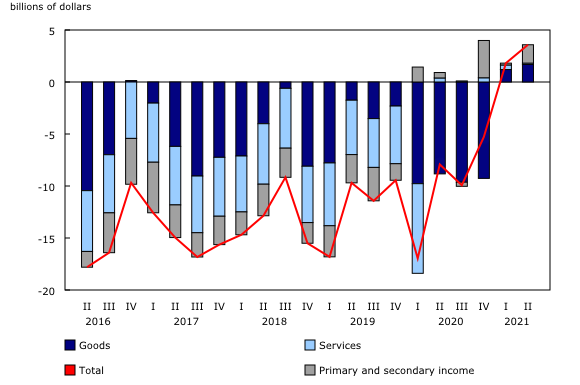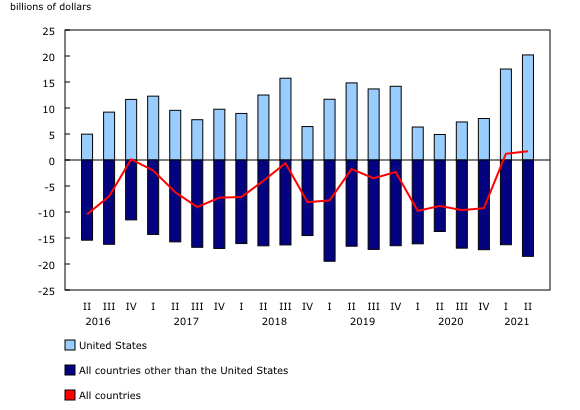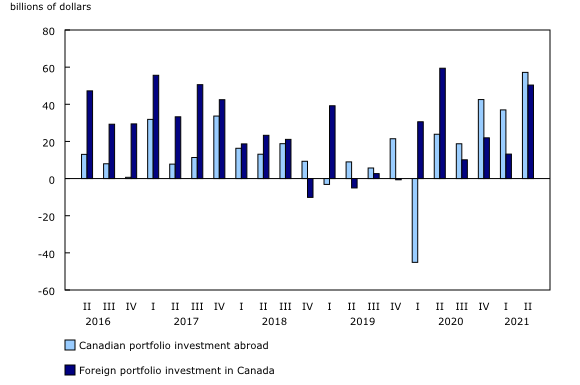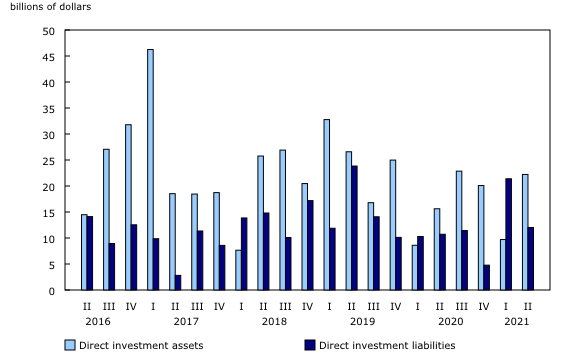Canada's balance of international payments, second quarter 2021
Archived Content
Information identified as archived is provided for reference, research or recordkeeping purposes. It is not subject to the Government of Canada Web Standards and has not been altered or updated since it was archived. Please "contact us" to request a format other than those available.
Released: 2021-08-30
$3.6 billion
Second quarter 2021
Canada's current account balance (on a seasonally adjusted basis) posted a $3.6 billion surplus in the second quarter, following a $1.8 million surplus in the first quarter. Prior to 2021, Canada had continuous current account deficits from the fourth quarter of 2008 until the end of 2020.
The surplus in the second quarter mostly reflected a positive trade in goods and services balance and a higher investment income surplus. The goods balance posted a second consecutive surplus, while the services balance remained in an unusual surplus position in the context of the COVID-19 pandemic, which affected travel payments more severely than receipts.
In the financial account (unadjusted for seasonal variation), portfolio and direct investment both led the net lending activity to non-residents in the quarter. For portfolio investment, record Canadian purchases of foreign shares in the context of continued strength of global stock markets was the main contributor.
Foreign direct investment generated a net outflow of funds totalling $10.2 billion in the second quarter, as direct investment abroad exceeded direct investment in Canada. Direct investment abroad rebounded, following lower investments in the first quarter. At the same time, direct investment in Canada slowed, mainly on lower merger and acquisition transactions.
Current account
Trade in goods and services still in a surplus position
The trade in goods and services balance posted a second consecutive surplus, reaching $1.8 billion in the second quarter. This surplus was led by higher exports of goods. Meanwhile, the trade in services balance remained in an unusual positive position from a historical perspective.
Exports of goods were up $0.9 billion to $153.2 billion in the second quarter, led by higher prices. The largest contributors were forestry products and building and packaging materials, up $2.0 billion on higher prices, as well as energy products, which increased by $1.6 billion, mostly on higher prices for crude petroleum. These increases were partially offset by lower exports of motor vehicles and parts, reflecting the impact of the global semi-conductor chip shortage, and by lower exports of aircraft and other transportation equipment and parts.
Imports of goods edged up $0.5 billion to $151.6 billion in the second quarter. Imports of motor vehicles and parts, also impacted by the shortage of semi-conductor chips, declined by $4.6 billion. However, this was more than offset by higher imports of other major goods, notably basic and industrial chemical, plastic and rubber products (+$1.6 billion) and metal and non-metallic mineral products (+$1.5 billion), both on higher volumes and prices.
On a geographical basis, the goods surplus with the United States rose by $2.7 billion in the second quarter on higher exports. The deficit with countries other than the United States expanded by $2.2 billion, mostly due to a lower surplus with the United Kingdom. Partially offsetting this movement was a $1.3 billion decline in the deficit with China.
The trade in services surplus fell by $302 million to $136 million, posting a positive balance for the fifth straight quarter. By type of services, the transportation services deficit increased as imports of sea transport were up in the quarter. The travel surplus decreased as fewer non-residents travelled to Canada during the second quarter compared with the first quarter. Travel receipts and payments remained at historical lows in Canada's current account as restrictions in the second quarter were still in force.
Profits on direct investment continue to rise
The investment income surplus was up by $1.7 billion to $4.0 billion in the second quarter, largely due to lower interest payments on loans and deposits held by non-residents.
Profits earned by Canadian direct investors on their assets abroad rose by $1.5 billion in the second quarter to a record $22.0 billion. Meanwhile, profits earned by foreign direct investors on their assets in Canada were up by $1.6 billion to $13.6 billion.
Financial account
Record Canadian investment in foreign securities
Canadian investors acquired a record $57.2 billion in foreign securities in the second quarter, up from $36.9 billion in the first quarter. Canadian investors increased their holdings of both shares and debt securities. More precisely, investors purchased $33.7 billion of US shares in the quarter, following acquisitions totalling $91.3 billion in the previous four quarters. Such continued and high levels of investments have never been seen in the past. At the same time, Canadian investors acquired $20.0 billion in foreign debt securities, almost evenly split between corporate and government instruments.
On the other side of the ledger, foreign investment in Canadian securities was also strong at $50.3 billion in the second quarter. Foreign investors acquired $33.8 billion of federal government debt securities, just below the investment level during the second quarter of 2020, in the wake of increased borrowing needs by the federal government to support Canadians affected by the pandemic. This followed a $24.3 billion divestment in these instruments in the first quarter.
Direct investment abroad increases
Direct investment abroad reached $22.2 billion in the second quarter, up from $9.7 billion in the first quarter. Mergers and acquisitions activity totalled $7.9 billion, the highest level in two years. The investment was mostly in the trade and transportation industry and in management of companies and enterprises. On a country basis, the largest share of the investment abroad was directed toward the United States and, to a lesser extent, the United Kingdom.
Direct investment in Canada totalled $12.0 billion in the second quarter. Equity investments made by foreign parents in Canadian affiliates, mainly in the form of reinvested earnings, were moderated by repayments of debt owed to foreign parents. Mergers and acquisitions activity totalled $1.6 billion in the second quarter, down from $5.8 billion in the first quarter. On a country basis, direct investment in Canada came primarily from the United States.
Note to readers
Definitions
The balance of international payments covers all economic transactions between Canadian residents and non-residents in three accounts: the current account, the capital account and the financial account.
The current account covers transactions in goods, services, compensation of employees, investment income and secondary income (current transfers).
The current account data in this release are seasonally adjusted. For information on seasonal adjustment, see Seasonally adjusted data – Frequently asked questions.
The capital account covers capital transfers and transactions in non-produced, non-financial assets.
The financial account covers transactions in financial assets and liabilities.
In principle, a net lending (+) or net borrowing (-) derived from the sum of the current and capital accounts corresponds to a net lending (+) or net borrowing (-) derived from the financial account. In practice, as data are compiled from multiple sources, this is rarely the case and gives rise to measurement error. The discrepancy (net errors and omissions) is the unobserved net inflow or outflow.
Foreign direct investment is presented on an asset-liability principle basis (that is, gross basis) in the financial account. Foreign direct investment can also be presented on a directional principle basis (that is, net basis), as shown in supplementary foreign direct investment tables 36-10-0025-01, 36-10-0026-01, 36-10-0473-01 and 36-10-0656-01. The difference between the two foreign direct investment conceptual presentations resides in the classification of reverse investment such as (1) Canadian affiliates' claims on foreign parents and (2) Canadian parents' liabilities to foreign affiliates. Under the asset-liability presentation, (1) is classified as an asset and included in direct investment assets, also referred to as direct investment abroad in this text, and (2) is classified as a liability and included in direct investment liability, also referred to as direct investment in Canada in this text.
For more information on the balance of payments, consult "Chapter 8. International Accounts," in the User Guide: Canadian System of Macroeconomic Accounts, available on our website. The chapter also presents the most recent balance of payments statistics.
Foreign direct investment on a gross and net basis
Data on flows of foreign direct investment in Canada and Canadian direct investment abroad on a gross and net basis are available in table 36-10-0656-01. This table provides details on both the increase and the decrease of inward and outward investments, broken down into equity and debt instruments and by type of foreign direct investment flow. These data are made available to further define the nature of foreign direct investment and shed light on investments that could be associated with greenfield investment and with extension of capacity, although no internationally agreed definition of this concept exists in foreign direct investment statistics. Such investments introduce additional resources and assets and contribute to gross fixed capital formation. Gross fixed capital formation data in the broader context of activities of multinational enterprises in Canada are available in table 36-10-0356-01 and include investment in machinery and equipment, non-residential construction, and intellectual property by type of multinational.
Real-time table
Real-time table 36-10-0042-01 will be updated on September 13. For more information, see Real-time tables.
Next release
Balance of international payments data for the third quarter will be released on November 29, 2021.
Products
The product Methodology for Exports of Energy Products within the International Merchandise Trade Program, which is part of Latest Developments in the Canadian Economic Accounts (13-605-X), is available.
The product Canada and the World Statistics Hub (13-609-X) is available online. This product illustrates the nature and extent of Canada's economic and financial relationship with the world using interactive graphs and tables. This product provides easy access to information on trade, investment, employment and travel between Canada and a number of countries, including the United States, the United Kingdom, Mexico, China and Japan.
The product Canada's international trade and investment country fact sheet(71-607-X2020001) is available online. This product provides easy and centralized access to Canada's international trade and investment statistics, on a country by country basis. It contains annual information for nearly 250 trading partners in summary form, including charts, tables and a short analysis that can also be exported in PDF format.
The Economic accounts statistics portal and International trade statistics are available from the Subjects module of our website.
The Methodological Guide: Canadian System of Macroeconomic Accounts (13-607-X) is available.
The User Guide: Canadian System of Macroeconomic Accounts (13-606-G) is also available.
Contact information
For more information, contact us (toll-free 1-800-263-1136; 514-283-8300; STATCAN.infostats-infostats.STATCAN@canada.ca).
To enquire about the concepts, methods or data quality of this release, contact Denis Caron (denis.caron@canada.ca), International Accounts and Trade Division.
- Date modified:





